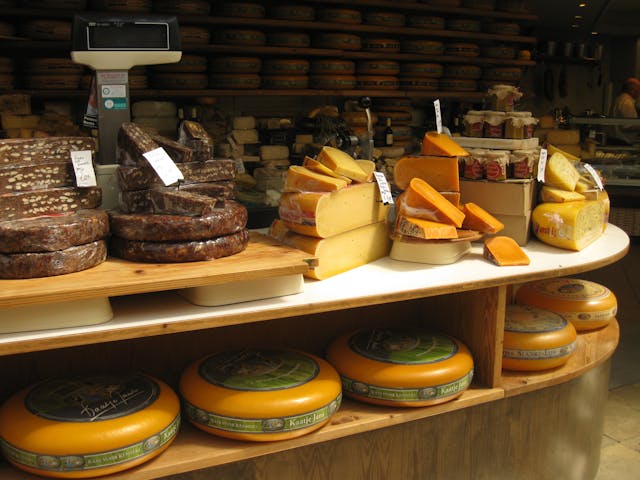
What are curds and whey? The curds are the coagulated proteins from milk and the whey is the left over liquid. Cheese is a diary product made by coagulating casein, which is the milk protein. Making milk into cheese is a good way of making it last much longer because cheese doesn’t spoil as fast as milk does.
Nobody knows when cheese was discovered, but it was probably about 10,000 years ago. The thinking behind this is that humans domesticated sheep around this time, and these were the first milk producing animals that we domesticated. The milk needed to be stored and it was probably stored in clay pots, but it would also have been stored in sheep’s stomachs, which make good, watertight containers. These sheep stomachs could have still contained rennet, which would have coagulated the milk and made the curds and whey separate. Rennet is found in all young ruminants and it is there to help them break down and digest the milk they drink. It disappears as they get older.
Interestingly, sheep were the second animal that humans domesticated. The first was the dog, roughly 15,000 years ago. That made sense because they were very useful for hunting and before we found agriculture, we were hunter gatherers. Then we domesticated sheep 10,000 years ago and pigs 2,000 years after that. We domesticated cattle shortly after pigs and we domesticated horses 6,000 years ago. That is surprisingly recent. After the discovery of cheese, it went through many evolutions and by the time of the Romans, there were many different types of cheeses. One of the oldest still eaten cheeses is called Pecorino romano and it is made from sheep’s milk. The Roman legionaries were given it as part of their ration. It lasts a long time and is easy to store. The legionaries were given 27 grams of it a day.
Cheese is made by coagulating the milk protein called casein. Coagulation is when a liquid changes into a solid state. We are most familiar with it in our blood. If we have a wound, the blood very quickly coagulates in the wound to seal it up. To make cheese, you have to remove the water. This is done by separating the milk into the curds and whey and to do this you have to make the milk coagulate. The first step is to add bacteria to the milk. This is the same thing that you do when making yoghurt, but the bacteria tend to be different. Different bacteria are used for different flavors of cheeses. The bacteria feed on the sugar in the milk, which is there as lactose, and create lactic acid as a byproduct. This lactic acid makes the milk start to curdle, which is another word for coagulate. The acid makes the casein in the milk, which is the main protein, unwind. When the proteins unwind, it is easier for them to get tangled up and they start to clump together. This is why you get lumps in milk if you let it get old.
At this point, the enzyme we found in sheep’s stomachs, rennet, is added. Rennet makes the proteins that were beginning to tangle together to join up and hold together. Once this has happened, the liquid can be removed from the cheese. The solid bits that have coagulated are the curds, and the liquid is the whey. These days, most cheese is made by using rennet produced in a lab because the only way of getting traditional rennet is by killing the young animal.
After the liquid has been removed, the curd is salted and then pressed. This gets out any remaining liquid and squashes the cheeses together into a shape that will hold. The cheese is then taken to be aged for one month to sometimes as long as two years. By altering the milk, the bacteria, or any of the other steps in the process, you can completely alter the taste and the texture of the cheese. That is why there are so many types of cheese. It is estimated that there are over 2,000 types of cheese.
Because they contain salt and they don’t contain any water, cheese will last for a very long time. It is a very inhospitable environment for bacteria to flourish. Although, of course, that depends on the type of cheese. Hard cheeses, such as Parmesan, are dried more than other cheeses and can last even longer. If you have a hard cheese and there is some mold on the edge, you can cut that bit off and still eat the rest of the cheese. And this is what I learned today.
Try these next:
Sources
https://en.wikipedia.org/wiki/Cheese
https://www.amnh.org/exhibitions/horse/domesticating-horses/domestication-timeline
https://en.wikipedia.org/wiki/Pecorino_romano
https://www.bleedingdisorders.com/about/how-blood-clots-coagulation
https://www.tastingtable.com/1212578/what-actually-is-curds-and-whey
https://www.thekitchn.com/the-science-behind-why-acid-curdles-milk-222962
https://www.kitchenaid.com/pinch-of-help/major-appliances/types-of-cheese.html
Photo by Carlo Primo: https://www.pexels.com/photo/dutch-cheese-shop-display-in-waalwijk-29412671/
